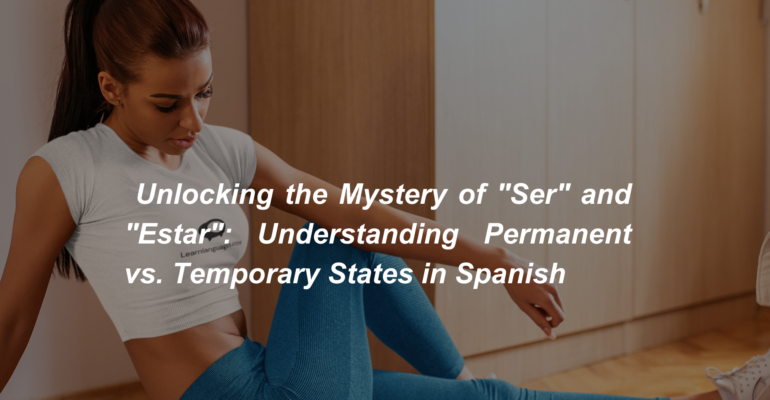Unlocking the Mystery of “Ser” and “Estar”: Understanding Permanent vs. Temporary States in Spanish
Unlocking the Mystery of “Ser” and “Estar”: Understanding Permanent vs. Temporary States in Spanish
Estimated reading time: 7 minutes
Introduction to “Ser” and “Estar” in Spanish
One of the most challenging aspects of learning Spanish, especially for native Hindi and English speakers, is understanding the difference between the verbs “ser” and “estar”. Both verbs translate to “to be” in English, but they are used in different contexts in Spanish.
Understanding when to use “ser” versus “estar” can be tricky, but it is essential for speaking Spanish accurately. This blog will explore the nuances between these two verbs, explain their forms, usage, and meanings, and provide comparisons with Hindi and English to help learners understand these differences more easily.

Understanding the Difference Between “Ser” and “Estar”
1. Forms and Usage of “Ser” and “Estar”
While “ser” and “estar” both mean “to be,” they serve different purposes in Spanish. The distinction primarily revolves around the concept of permanence versus temporariness.
- Ser is used to express permanent states or characteristics. It refers to identity, inherent traits, professions, time, and origins.
- Estar is used to express temporary states or conditions. It describes emotions, locations, and conditions that are likely to change.
Forms of “Ser” and “Estar”:
“Ser” and “estar” are both irregular verbs, meaning they do not follow the regular conjugation patterns. Here are their present tense forms:
| Pronoun | Ser | Estar |
|---|---|---|
| Yo | soy | estoy |
| Tú | eres | estás |
| Él/Ella/Usted | es | está |
| Nosotros/as | somos | estamos |
| Vosotros/as | sois | estáis |
| Ellos/Ellas/Ustedes | son | están |
2. Usage and Meaning in Different Contexts
“Ser” Usage:
“Ser” is generally used to describe qualities that are seen as permanent or unchanging. Here are some common uses:
- Identity and Characteristics:
- Yo soy estudiante. (I am a student.)
- Hindi: मैं छात्र हूँ। (Main chhatra hoon.)
- Origin and Nationality:
- Ella es de México. (She is from Mexico.)
- Hindi: वह मेक्सिको से है। (Vah Mexico se hai.)
- Profession:
- Nosotros somos doctores. (We are doctors.)
- Hindi: हम डॉक्टर हैं। (Hum doctor hain.)
- Time and Dates:
- Hoy es lunes. (Today is Monday.)
- Hindi: आज सोमवार है। (Aaj somvaar hai.)
- Material Composition:
- La mesa es de madera. (The table is made of wood.)
- Hindi: मेज लकड़ी की है। (Mez lakdi ki hai.)
“Estar” Usage:
“Estar” is used to describe states or conditions that are temporary or likely to change:
- Location:
- El libro está en la mesa. (The book is on the table.)
- Hindi: किताब मेज पर है। (Kitaab mez par hai.)
- Temporary States or Conditions:
- Estoy cansado. (I am tired.)
- Hindi: मैं थका हुआ हूँ। (Main thaka hua hoon.)
- Emotions and Feelings:
- Ellos están felices. (They are happy.)
- Hindi: वे खुश हैं। (Ve khush hain.)
- Ongoing Actions (Present Progressive):
- Estamos comiendo. (We are eating.)
- Hindi: हम खा रहे हैं। (Hum kha rahe hain.)
Comparing “Ser” and “Estar” with Hindi and English Equivalents
Understanding “ser” and “estar” can be simplified by comparing them to similar structures in Hindi and English.
- English Comparison:In English, the verb “to be” is used for both temporary and permanent states, which can cause confusion for learners when choosing between “ser” and “estar” in Spanish. However, English often uses adjectives or additional words to clarify if a state is temporary or permanent:
- She is a teacher. (Permanent)
- She is being kind. (Temporary)
- Hindi Comparison:Hindi, like English, uses the verb “होना” (hona) for “to be,” and it can indicate both permanent and temporary states depending on context and additional words. For instance:
- वह एक डॉक्टर है। (Vah ek doctor hai.) – “She is a doctor.” (Permanent)
- वह आज खुश है। (Vah aaj khush hai.) – “She is happy today.” (Temporary)
By understanding these differences in Hindi and English, learners can better grasp when to use “ser” and “estar” in Spanish.
Grammar Pattern Breakdown: Components of “Ser” and “Estar”
To fully understand the differences between “ser” and “estar,” it is essential to break down their usage into specific components:
- Ser: Permanent States
- Identity: Refers to who or what someone or something is.
- Characteristics: Describes inherent qualities that do not change.
- Origin and Nationality: Indicates where someone or something is from.
- Profession: Describes someone’s occupation or role.
- Time and Date: States the current time or date.
- Material Composition: What something is made of.
- Estar: Temporary States
- Location: Specifies where someone or something is.
- Temporary Conditions: Describes physical or mental states that are not permanent.
- Emotions and Feelings: Expresses temporary emotional states.
- Present Progressive: Describes ongoing actions in the present.
-
Product on sale
 French DELF B1
French DELF B1₹32,600.00
₹36,300.00
Exceptions and Irregularities
While “ser” and “estar” generally follow the patterns above, there are some exceptions and special cases where the choice between them might not be as straightforward:
- Adjectives That Change Meaning: Some adjectives change meaning depending on whether they are used with “ser” or “estar.”
- Ser aburrido (to be boring) vs. Estar aburrido (to be bored)
- Example:Ella es aburrida. (She is boring.)
- Hindi: वह उबाऊ है। (Vah ubaau hai.)
- Example:Ella está aburrida. (She is bored.)
- Hindi: वह बोर हो रही है। (Vah bor ho rahi hai.)
- Special Expressions: Certain expressions traditionally use “estar” even though they might seem permanent.
- Estar casado (to be married)
- Example:Él está casado. (He is married.)
- Hindi: वह विवाहित है। (Vah vivaahit hai.)
- Describing Food: When describing how food generally is, “ser” is used, but when describing a specific meal’s state, “estar” is used.
- El pastel es delicioso. (Cake is delicious.)
- Hindi: केक स्वादिष्ट है। (Cake swadisht hai.)
- Este pastel está delicioso. (This cake is delicious.)
- Hindi: यह केक स्वादिष्ट है। (Yeh cake swadisht hai.)
- El pastel es delicioso. (Cake is delicious.)
Example Sentences Using “Ser” and “Estar”
Here are six example sentences illustrating the differences between “ser” and “estar,” with translations in English and Hindi:
- Spanish: Soy médico.
English: I am a doctor.
Hindi: मैं डॉक्टर हूँ। (Main doctor hoon.) - Spanish: Estoy en el hospital.
English: I am at the hospital.
Hindi: मैं अस्पताल में हूँ। (Main aspataal mein hoon.) - Spanish: Ella es inteligente.
English: She is intelligent.
Hindi: वह बुद्धिमान है। (Vah buddhimaan hai.) - Spanish: Ella está cansada después del trabajo.
English: She is tired after work.
Hindi: वह काम के बाद थकी हुई है। (Vah kaam ke baad thaki hui hai.) - Spanish: Nosotros somos amigos desde la infancia.
English: We have been friends since childhood.
Hindi: हम बचपन से दोस्त हैं। (Hum bachpan se dost hain.) - Spanish: Nosotros estamos felices de verte.
English: We are happy to see you.
Hindi: हम आपको देखकर खुश हैं। (Hum aapko dekhkar khush hain.)
Frequently Asked Questions (FAQs)
Conclusion
Mastering the use of “ser” and “estar” is essential for anyone learning Spanish, as it helps convey the correct meaning in conversations and writing. By understanding the differences between these two verbs and practicing their usage, learners can achieve greater fluency and avoid common mistakes. Remember to think about the permanence or temporariness of the state or condition you are describing, and choose “ser” or “estar” accordingly. With practice, you’ll soon be using these verbs like a native speaker!
Enhance Your Spanish Skills!
To improve your Spanish further, consider enrolling in our Spanish Course at Learn Languages Store for just Rs. 16,300. Our courses are designed to help you build a strong foundation in the Spanish language in a fun and engaging way.
Contact Us to Learn More!
For more information about our courses, feel free to reach out to us at:
Address:
330, 3rd Floor, Big Splash (Near Vashi Bus Depot),
Sector 17, Vashi,
Navi Mumbai, Maharashtra 400703
Phone: +91-9594113111
Email: services@learnlanguages.store
Don’t miss the opportunity to enhance your language skills! Sign up today and start your journey to fluency in Spanish!










